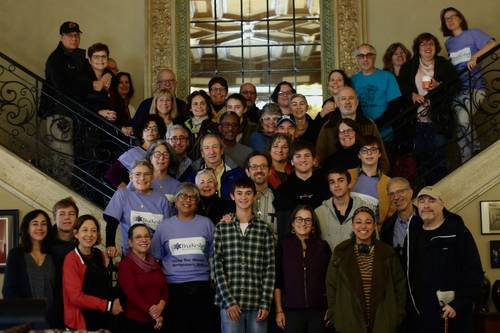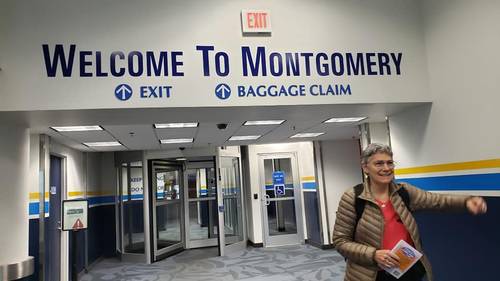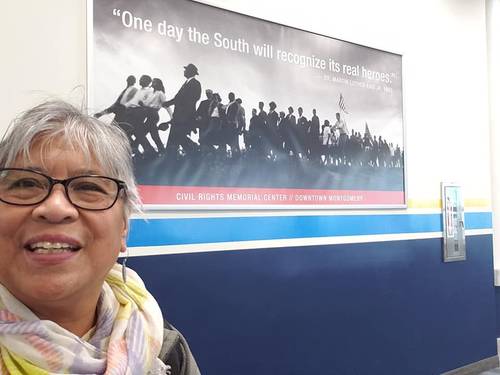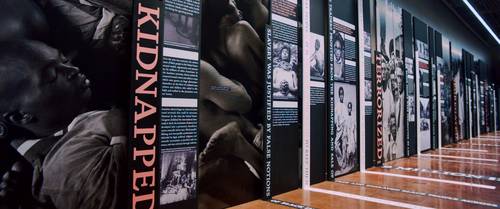- About Us
- Calendar
- Religious Life
- Learning
- Repairing
- Connecting
- My Account
Montgomery Trip
BK Trip to Montgomery, Alabama: Facing the History of Racial Injustice in the US November 7 - 10, 2019




BK’s Montgomery Experience
43 Jews and friends / 43 teens and adults / 43 mostly from New Jersey / 43 committed students on a quest to uncover truths / 43 who will not be silent
Members of Bnai Keshet Reconstructionist Synagogue travelled to Montgomery, Alabama this past Thursday through Sunday to visit the city many have labeled the epicenter of the American Slave trade and the place where Bryan Stevenson and associates created the Equal Justice Institute (EJI), the Legacy Museum: From Enslavement to Mass Incarceration and the National Memorial for Peace and Justice (also known as the Lynching Memorial).
Our Synagogue has spent the better part of the year preparing for this trip with study groups, Jewish text studies, sermons (on Slavery to Mass Incarceration, The role of Jews in Southern Slavery); lectures by guests such as Tanya Coke (Director, Gender, Racial, and Ethnic Justice at the Ford Foundation) and Randy Susskind (Deputy Director, Equal Justice Institute), and community building exercises.
We met in Montgomery and opened our time in the South with a text study led by Rabbi Ariann Weitzman who helped center our experience through a Jewish lens, examining the legacy of slavery in our own texts, and encouraging us to do the work of turning history into communal memory. We then spent Friday, November 8th with Michelle Browder who runs More Than Tours (https://www.iammorethan7053.com/more-than-tours). Her outstanding Civil Rights tour was founded out of necessity for travelers to learn about “Alabama’s rich history as the Cradle of the Confederacy and Birth Place of the Civil Rights Movement”. We lunched with her father who has worked in the Alabama prison system for the past 40+ years and was given that job by Governor George Wallace. He was the first African American minister in Alabama penitentiaries, and he spoke about the bridge between slavery and present day mass incarceration of men and women of color with penetrating truths. Michelle’s aunt, Aurelia Browder, was the first named plaintiff in Browder vs. Gayle. This case declared segregated public busing unconstitutional and ended the bus boycott. Our day with Michelle was spiritually and informationally profound.
We then spent all of Saturday, which also coincided with the date of Kristallnacht in 1938, at the museum and Lynching memorial. EJI created these to address the missing history behind “racial inequality and economic injustice in the United States since little has been done to acknowledge the legacy of genocide, slavery, lynching, and racial segregation.” What made the museum so compelling was the use of narratives as a profoundly emotional teaching tool to portray the sustained injustices across generations. The Legacy Museum used technology to “dramatize the enslavement of African Americans, the evolution of racial terror lynchings, legalized racial segregation and racial hierarchy in America.” Using rarely seen first-person accounts, I was laid bare as I entered to hear the Spirituals from a caged woman and the cries of two children calling fearfully “mama? Mama?” Moving through the museum space was a walk through individual histories that wove together a fabric of terror and dehumanization from Slavery, Reconstruction, Jim Crow to mass incarceration today.
Before entering the Memorial, we gathered for a conversation with two brilliant young women who work at EJI. We recited the Mourners Kaddish then entered the Lynching Memorial. It is an unparalleled artistic expression and is the most comprehensive collection of names of men, women and children lynched in the United States. The memorial used sculpture, art, and design to contextualize racial terror. The memorial square with “800 six-foot monuments symbolizes thousands of racial terror lynching victims in the United States and the counties and states where this terrorism took place.” Our emotional day ended with a conversation with three women from Alabama’s Poor People’s Campaign who spoke about current issues of poverty, incarceration, and their state and national work.
Slavery to mass incarceration is not a Southern issue. The North was complicit in using the commerce produced by slave labor with little protest and Northern states were listed in EJI’s Lynching records. The integration of the narrative of racial difference which was at the core of White’s justification for the brutal and dehumanizing institution of slavery in America still manifests in urban ghettos and generational poverty. This is an American story and one that must be learned in order to correct its trajectory.
I left the museum and memorial, as did so many from our group, believing in the power of learning from these profound heart-opening spaces and wondering if this presentation of the material might finally offer a method, an opening for all who are willing to truly learn this history.
On Sunday we left Alabama mourning the abuses and violations perpetrated by White Americans. It is incomprehensible that humans can treat anything living with such brutality. We are also energized and motivated to work together on formulating our next steps of courageous activism. Tikkun Olam is essential in its truest sense.
Sat, November 29 2025
9 Kislev 5786
Upcoming Events
©2024 All rights reserved. Find out more about ShulCloud
Privacy Settings | Privacy Policy | Member Terms
©2025 All rights reserved. Find out more about ShulCloud
